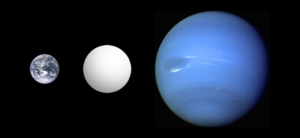COROT-Exo-7b facts for kids
COROT-Exo-7b is a fascinating planet that orbits a star far, far away from our Sun. Scientists call planets outside our solar system "exoplanets." This particular exoplanet circles its star, named COROT-Exo-7, in a part of space known as the constellation Monoceros. It's about 489 light years from Earth, which means it's incredibly far away! A light year is the distance light travels in one year.
This amazing planet was first discovered in 2009 by a special space mission called COROT, led by France. For a while, COROT-Exo-7b was the smallest exoplanet whose size had been measured. It's about 1.58 times wider than Earth, making its total volume almost four times bigger than Earth's. It was also the first time scientists found a planet outside our solar system that might be a rocky planet, like Earth. Another cool thing about COROT-Exo-7b is how fast it orbits its star. It takes only about 20 hours to complete one full trip around its star!
Contents
What is COROT-Exo-7b?
COROT-Exo-7b is an exoplanet, which means it's a planet that orbits a star other than our Sun. It's often called a "Super-Earth" because it's larger than Earth but still likely a rocky planet. Imagine a planet made mostly of rock, just like Earth, but quite a bit bigger!
Size and Type
Scientists have measured COROT-Exo-7b to be about 1.58 times the diameter of Earth. This means it's almost twice as wide as our home planet. Because it's so big and likely made of rock, it's considered a "terrestrial planet." Terrestrial planets are rocky planets, like Mercury, Venus, Earth, and Mars in our own solar system.
Orbit and Speed
One of the most amazing things about COROT-Exo-7b is its super-fast orbit. It takes only about 20 hours for this planet to go all the way around its star. To give you an idea, Earth takes 365 days to orbit the Sun! This super-fast orbit means COROT-Exo-7b is very, very close to its star.
How Was COROT-Exo-7b Discovered?
COROT-Exo-7b was found by the COROT space telescope. This telescope was launched into space to look for exoplanets. It uses a method called "transit photometry."
The Transit Method
The transit method works by watching a star very carefully. If a planet passes in front of its star, it blocks a tiny bit of the star's light. When this happens, the star's brightness dips for a short time. By measuring these tiny dips in light, scientists can figure out if a planet is there and even how big it is. This is how COROT-Exo-7b was detected in 2009.
Why is COROT-Exo-7b Special?
This exoplanet holds a special place in the history of planet discovery. It was a groundbreaking find for several reasons.
First Potential Rocky Exoplanet
Before COROT-Exo-7b, most of the exoplanets found were very large gas giants, like Jupiter or Neptune. COROT-Exo-7b was the first exoplanet that scientists thought could be a rocky planet, similar to Earth. This was a huge step in the search for other Earth-like worlds.
Smallest Measured Exoplanet (for a time)
When it was first announced, COROT-Exo-7b was the smallest exoplanet whose size had been accurately measured. This showed that our telescopes were getting good enough to find smaller planets, not just the giant ones.
What is it Like on COROT-Exo-7b?
Because COROT-Exo-7b orbits so close to its star, it's likely a very extreme place.
Extreme Temperatures
The side of the planet facing its star would be incredibly hot, possibly hot enough to melt rock and create lava oceans. The other side, always facing away from the star, would be very cold. It's a world of extreme differences!
Images for kids
-
Artist conception of CoRoT-7b transiting yellow dwarf CoRoT-7
-
Artist's impression of CoRoT-7b. Credit: ESO/L. Calçada.
See also
 In Spanish: COROT-7b para niños
In Spanish: COROT-7b para niños





